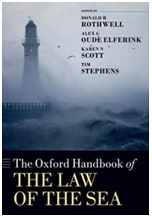The United Nations Convention on the Law of the Sea comprehensively defined the parameters of the law of the sea in 1982, and since the Convention was concluded it has seen considerable development.
Edited by Donald Rothwell, Alex Oude Elferink, Karen Scott, and Tim Stephens
Human activities have taken place in the world’s oceans and seas for most of human history. With such a vast number of ways in which the oceans can be used for trade, exploited for natural resources and fishing, as well as concerns over maritime security, the legal systems regulating the rights and responsibilities of nations in their use of the world’s oceans have long been a crucial part of international law.

The United Nations Convention on the Law of the Sea comprehensively defined the parameters of the law of the sea in 1982, and since the Convention was concluded it has seen considerable development. This book provides an analysis of its current debates and controversies, both theoretical and practical. It consists of forty chapters divided into six parts. First, it explains the origins and evolution of the law of the sea, with a particular focus upon the role of key publicists such as Hugo Grotius and John Selden, the gradual development of state practice, and the creation of the 1982 UN Convention.
It then reviews the components which comprise the maritime domain, assessing their definition, assertion, and recognition. It also analyzes the ways in which coastal states or the international community can assert control over areas of the sea, and the management and regulation of each of the maritime zones. This includes investigating the development of the mechanisms for maritime boundary delimitation, and the decisions of the International Tribunal for the Law of the Sea. The book also discusses the actors and intuitions that impact on the law of the sea, considering their particular rights and interests, in particular those of state actors and the principle law of the sea institutions.
Then it focuses on operational issues, investigating longstanding matters of resource management and the integrated oceans framework. This includes a discussion and assessment of the broad and increasingly influential integrated oceans management governance framework that interacts with the traditional law of the sea. It considers six distinctive regions that have been pivotal to the development of the law of the sea, before finally providing a detailed analysis of the critical contemporary issues facing the law of the sea. These include threatened species, climate change, bioprospecting, and piracy.
The adoption and opening for signature of the United Nations Convention on the Law of the Sea (LOSC) at Montego Bay, Jamaica, on 10 December 1982, and its entry into force on 16 November 1994, constitute a major contribution of the United Nations to the development of international law. To a large extent, the Convention, presently (January 2015) ratified or acceded to by 167 parties, represents a codification of customary international law. However, it also contains important advances of the law of the sea.
The potential for disputes and conflicts relating to the law of the sea is great. However, because of the manner in which the Convention establishes the law and provides methods for resolving disputes, the Convention can actually be regarded as making a major contribution to the maintenance of international peace and security. This was noted by the General Assembly in its resolution recognizing the entry into force of the LOSC, where the Assembly recalled the historic significance of the Convention ‘as an important contribution to the maintenance of peace, justice, and progress for all peoples of the world’. The Convention has even been described as the most successful treaty adopted by the international community since the adoption of the 1945 Charter of the United Nations.























